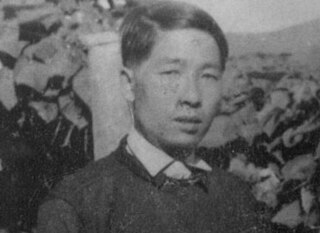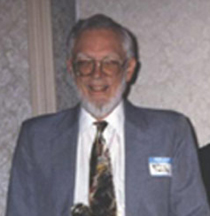The Romanized Popular Alphabet (RPA) or Hmong RPA (also Roman Popular Alphabet), is a system of romanization for the various dialects of the Hmong language. Created in Laos between 1951 and 1953 by a group of missionaries and Hmong advisers, it has gone on to become the most widespread system for writing the Hmong language in the West. It is also used in Southeast Asia and China alongside other writing systems, most notably Nyiakeng Puachue Hmong and Pahawh Hmong. [1]
In Xiangkhoang Province, Protestant missionary G. Linwood Barney began working on the writing system with speakers of Green Mong (Mong Leng), Geu Yang and Tua Xiong, among others. He consulted with William A. Smalley, a missionary studying the Khmu language in Luang Prabang Province at the time. Concurrently, Yves Bertrais, a Roman Catholic missionary in Kiu Katiam, Luang Prabang, was undertaking a similar project with Chong Yeng Yang and Chue Her Thao. The two working groups met in 1952 and reconciled any differences by 1953 to produce a version of the script. [2]
The alphabet was developed to write both the Hmong Der (White Hmong, RPA: Hmoob Dawb) and Mong Leng (Green/Blue Mong, RPA: Moob Leeg) dialects. While these dialects have much in common, each has unique sounds. Consonants and vowels found only in Hmong Der (denoted with †) or Green Mong (denoted with ⁂) are color-coded respectively. [3] Some writers make use of variant spellings. Much as with Tosk for Albanian, Hmong Der was arbitrarily chosen to be the "standard" variant.
| Occlusives | Nasals | Stops | l | Affricates | ||||||||||||
|---|---|---|---|---|---|---|---|---|---|---|---|---|---|---|---|---|
| ny | n | m | ml | p | pl | t | d† | dl⁂ | r | c | k | q | tx | ts | ||
| Unmodified | /ɲ/ | /n/ | /m/ | /mˡ/ | /p/ | /pˡ/ | /t/ | /d/† | /tˡ/⁂ | /ʈ/ | /c/ | /k/ | /q/ | /l/ | /ts/ | /ʈʂ/ |
| Preceding ⟨n⟩ | np /ᵐb/ | npl /ᵐbˡ/ | nt /ⁿd/ | ndl /ⁿdˡ/⁂ | nr /ᶯɖ/ | nc /ᶮɟ/ | nk /ᵑɡ/ | nq /ᶰɢ/ | ntx /ⁿdz/ | nts /ᶯɖʐ/ | ||||||
| Preceding/Following ⟨h⟩ | hny /ɲ̥/† | hn /n̥/† | hm /m̥/† | hml /m̥ɬ/† | ph /pʰ/ | plh /pɬ/ | th /tʰ/ | dh /dʱ/† | dlh /tɬ/⁂ | rh /ʈʰ/ | ch /cʰ/ | kh /kʰ/ | qh /qʰ/ | hl /ɬ/ | txh /tsʰ/ | tsh /ʈʂʰ/ |
| ⟨n⟩ and ⟨h⟩ | nph /ᵐpʰ/ | nplh /ᵐpɬ/ | nth /ⁿtʰ/ | ndlh /ⁿtɬ/⁂ | nrh /ᶯʈʰ/ | nch /ᶮcʰ/ | nkh /ᵑkʰ/ | nqh /ᶰqʰ/ | ntxh /ⁿtsʰ/ | ntsh /ᶯʈʂʰ/ | ||||||
| Fricatives | Labial | Coronal | Dorsal | Glottal | ||||
|---|---|---|---|---|---|---|---|---|
| f | v | x | s | z | y | xy | h | |
| /f/ | /v/ | /s/ | /ʂ/ | /ʐ/ | /ʝ/ | /ç/ | /h/ | |
| Vowels | Monophthongs | Nasalized | Diphthongs | |||||||||||
|---|---|---|---|---|---|---|---|---|---|---|---|---|---|---|
| i | e | a | o | u | w | ee | aa⁂ | oo | ai | aw | au | ia† | ua | |
| /i/ | /e/ | /a/ | /ɔ/ | /u/ | /ɨ/ | /ẽ/ | /ã/⁂ | /ɔ̃/ | /ai/ | /aɨ/ | /au/ | /iə/† | /uə/ | |
RPA indicates tone by letters written at the end of a syllable, [4] like Gwoyeu Romatzyh rather than with diacritics like those used in the Vietnamese alphabet or Pinyin. Unlike Vietnamese and Chinese, all Hmong syllables end in a vowel, which means that using consonant letters to indicate tone will be neither confusing nor ambiguous.
| Tone | Example [5] | Orthographic Spelling |
|---|---|---|
| High | /pɔ́/ 'ball' | pob |
| Mid | /pɔ/ 'spleen' | po |
| Low | /pɔ̀/ 'thorn' | pos |
| High falling | /pɔ̂/ 'female' | poj |
| Mid rising | /pɔ̌/ 'to throw' | pov |
| Creaky | /pɔ̰/ 'to see' | pom1 |
| Low falling breathy | /pɔ̤/ 'grandmother' | pog |
Breathy voice is a phonation in which the vocal folds vibrate, as they do in normal (modal) voicing, but are adjusted to let more air escape which produces a sighing-like sound. A simple breathy phonation,, can sometimes be heard as an allophone of English between vowels, such as in the word behind, for some speakers.
Tone is the use of pitch in language to distinguish lexical or grammatical meaning—that is, to distinguish or to inflect words. All oral languages use pitch to express emotional and other para-linguistic information and to convey emphasis, contrast and other such features in what is called intonation, but not all languages use tones to distinguish words or their inflections, analogously to consonants and vowels. Languages that have this feature are called tonal languages; the distinctive tone patterns of such a language are sometimes called tonemes, by analogy with phoneme. Tonal languages are common in East and Southeast Asia, Africa, the Americas and the Pacific.

The Hmong people are an indigenous group in East Asia and Southeast Asia. In China, the Hmong people are classified as a sub-group of the Miao people. The modern Hmong reside mainly in Southwest China and countries in Southeast Asia such as Vietnam, Laos, Thailand, and Myanmar. There is also a large diasporic community in the United States of more than 300,000. The Hmong diaspora has smaller communities in Australia and South America.
Historical Chinese phonology deals with reconstructing the sounds of Chinese from the past. As Chinese is written with logographic characters, not alphabetic or syllabary, the methods employed in Historical Chinese phonology differ considerably from those employed in, for example, Indo-European linguistics; reconstruction is more difficult because, unlike Indo-European languages, no phonetic spellings were used.
Lao script or Akson Lao is the primary script used to write the Lao language and other minority languages in Laos. Its earlier form, the Tai Noi script, was also used to write the Isan language, but was replaced by the Thai script. It has 27 consonants, 7 consonantal ligatures, 33 vowels, and 4 tone marks.
A nasal vowel is a vowel that is produced with a lowering of the soft palate so that the air flow escapes through the nose and the mouth simultaneously, as in the French vowel /ɑ̃/ or Amoy []. By contrast, oral vowels are produced without nasalization. This precedes.

The Hmong–Mien languages are a highly tonal language family of southern China and northern Southeast Asia. They are spoken in mountainous areas of southern China, including Guizhou, Hunan, Yunnan, Sichuan, Guangxi, Guangdong and Hubei provinces; the speakers of these languages are predominantly "hill people", in contrast to the neighboring Han Chinese, who have settled the more fertile river valleys.

Canadian syllabic writing, or simply syllabics, is a family of writing systems used in a number of Indigenous Canadian languages of the Algonquian, Inuit, and (formerly) Athabaskan language families. These languages had no formal writing system previously. They are valued for their distinctiveness from the Latin script and for the ease with which literacy can be achieved. For instance, by the late 19th century the Cree had achieved what may have been one of the highest rates of literacy in the world.

Hmong or Mong is a dialect continuum of the West Hmongic branch of the Hmongic languages spoken by the Hmong people of Sichuan, Yunnan, Guizhou, Guangxi, Hainan, northern Vietnam, Thailand, and Laos. There are some 2.7 million speakers of varieties that are largely mutually intelligible, including over 280,000 Hmong Americans as of 2013. Over half of all Hmong speakers speak the various dialects in China, where the Dananshan (大南山) dialect forms the basis of the standard language. However, Hmong Daw and Mong Leng are widely known only in Laos and the United States; Dananshan is more widely known in the native region of Hmong.

The Yi scripts are two scripts used to write the Yi languages; Classical Yi, and the later Yi syllabary. The script is historically known in Chinese as Cuan Wen or Wei Shu and various other names (夷字、倮語、倮倮文、畢摩文), among them "tadpole writing" (蝌蚪文).

The Pollard script, also known as Pollard Miao or Miao, is an abugida loosely based on the Latin alphabet and invented by Methodist missionary Sam Pollard. Pollard invented the script for use with A-Hmao, one of several Miao languages spoken in southeast Asia. The script underwent a series of revisions until 1936, when a translation of the New Testament was published using it.

Shong Lue Yang was a Hmong spiritual leader and creator of the Pahawh script, a semi-syllabary for writing dialects of the Hmong language, as well as the Khmu language.

Pahawh Hmong is an indigenous semi-syllabic script, invented in 1959 by Shong Lue Yang, to write two Hmong languages, Hmong Daw (Hmoob Dawb White Miao) and Hmong Njua AKA Hmong Leng (Moob Leeg Green Miao).

The Hmongic languages, also known as Miao languages, include the various languages spoken by the Miao people. Hmongic languages also include various languages spoken by non-Mienic-speaking Yao people, such as Pa-Hng, Bunu, Jiongnai, Younuo, and others, while She is spoken by ethnic She people.
The A-Hmao language, also known as Large Flowery Miao or Northeast Yunnan Miao, is a Hmongic language spoken in China. It is the language the Pollard script was designed for, and displays extensive tone sandhi. There is a high degree of literacy in Pollard among the older generation.
Mang, or Mashan Miao also known as Mashan Hmong, is a Miao language of China, spoken primarily in Ziyun Miao and Buyei Autonomous County, southwestern Guizhou province, southwest China. The endonym is Mang, similar to other West Hmongic languages such as Mong.
Hmong writing refers to the various writing systems that have been used for transcribing various Hmongic languages, spoken by Hmong people in China, Vietnam, Laos, the United States, and Thailand, these being the top five countries. Over a dozen scripts have been reported for Hmong, none of which is considered standard for transcribing the languages in the eyes of the speakers.

William Allen Smalley was an American linguist. He is best known for his role in the development of the Romanized Popular Alphabet for the Hmong language.

Ban Phou Pheung Noi is a Laotian village located at the peak of Phou Pheung mountain in the Xieng Khouang province of Laos. Phou Pheung mountain is approximately 916 m (3,005 ft). During the Vietnam War, combat between the American allies, the Hmong, and the Pathet Lao, The Laos Marxist government, and the Communist North Vietnamese People's Army took place on the mountain. Phou Pheung mountain runs from east to west and is rocky, and is covered in tropical forests. It is south of Muang Soui - Nongtang-Nato, and west of Phou Douk, Muang Phuan, Phonsavan and Plain of Jars. To the east, about 10 miles from Ban Phou Pheung Noi, is the Num Ngum 4 hydroelectric dam.